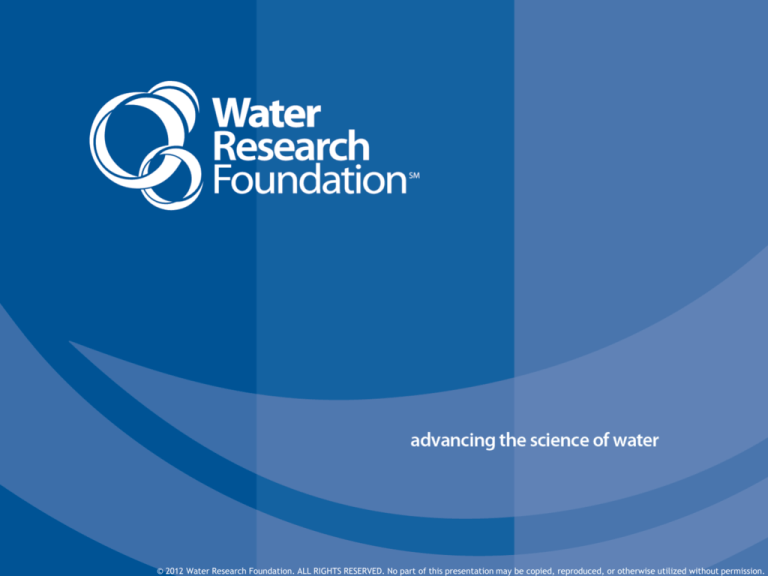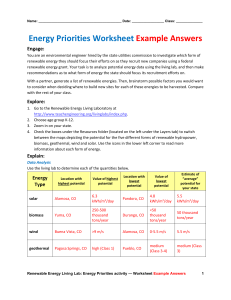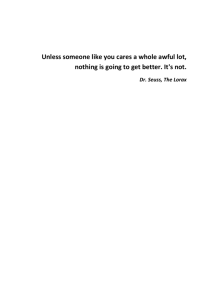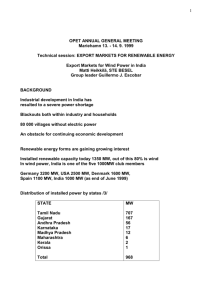
© 2012
Water Research
Foundation.
ALLwithout
RIGHTSpermission.
RESERVED.
© 2012 Water Research Foundation. ALL RIGHTS RESERVED. No part of this presentation may be copied,
reproduced,
or otherwise
utilized
Implementing Renewable
Energy at Water Utilities
Project 4424
November 8, 2012
© 2012 Water Research Foundation. ALL RIGHTS RESERVED.
Outline
•
•
•
•
•
•
Why renewable energy?
Renewable energy technologies
Implementation considerations
Procurement options
Funding opportunities
Case studies - opportunities, challenges,
and barriers to project implementation
© 2012 Water Research Foundation. ALL RIGHTS RESERVED.
Why renewable energy?
• Economic Benefits
—Offset purchased power
—Possible green credits, REC, carbon credits
• Environmental Benefits
—Reduce carbon footprint
—Mitigate effects of the water-energy nexus
• Social Benefits
—Very positive public perception
© 2012 Water Research Foundation. ALL RIGHTS RESERVED.
Projected Electricity Price
© 2012 Water Research Foundation. ALL RIGHTS RESERVED.
Cost To Treat Water Is Increasing
Water demands are
increasing
Energy to treat water is
increasing
Cost of energy is
increasing
© 2012 Water Research Foundation. ALL RIGHTS RESERVED.
Renewable Energy Outlook
© 2012 Water Research Foundation. ALL RIGHTS RESERVED.
Environmental Benefits
• 1000 KWH of purchased electric utility
power releases an average of 0.61 tons of
CO2 equivalent.
• Renewable reduces grid losses. US average
grid losses = 6.5%
• 1000KWH generated locally actually saves
1065KWH of electric utility generation
(Source: USEPA eGRID2012)
© 2012 Water Research Foundation. ALL RIGHTS RESERVED.
Water-Energy Nexus
• 1kWh of purchased electric energy
requires ~25 gallons of fresh water to
produce
• Water treatment and distribution average
energy usage: 1250 - 2500 kWh/MG
• For every million gallons treated, an
additional 31,250 to 62,500 gallons of
water resources are consumed.
© 2012 Water Research Foundation. ALL RIGHTS RESERVED.
Renewable Energy Technologies
•
•
•
•
•
•
Solar
Wind
Micro-hydro
Geothermal
Tidal
Biomass
© 2012 Water Research Foundation. ALL RIGHTS RESERVED.
Solar
• Advantages:
—Widely available
—Mature technology
—Low maintenance costs
—Prices are decreasing
• Disadvantages:
—Intermittent power generation
—Power output depends on solar irradiance
—Large footprint
© 2012 Water Research Foundation. ALL RIGHTS RESERVED.
Types of Solar Systems
• Photovoltaic Systems – Converts sun light
energy into electric energy
• Thermal Systems – Recovers thermal
energy from sun light
© 2012 Water Research Foundation. ALL RIGHTS RESERVED.
© 2012 Water Research Foundation. ALL RIGHTS RESERVED.
Wind
• Advantages:
— Small site footprint
— Mature technology
• Disadvantages:
— Low persistent noise depending on
design
— Aesthetic concerns
— Intermittent nature
— Sufficient wind not available in
many areas
© 2012 Water Research Foundation. ALL RIGHTS RESERVED.
© 2012 Water Research Foundation. ALL RIGHTS RESERVED.
Micro-hydro
• Advantages:
—Low maintenance costs
—Mature technology
—Installation in a
pipeline or outfall
• Disadvantages:
—Power output is dependent on
elevation changes
—Limited availability in small sizes
© 2012 Water Research Foundation. ALL RIGHTS RESERVED.
Types of Micro-hydro Systems
• Hydroturbines
• Pumps as Turbines
Source: VATech Hydro
© 2012 Water Research Foundation. ALL RIGHTS RESERVED.
Tidal
• Advantages:
—Predictable
—High energy density
• Disadvantages:
Image Source: www.reuk.co.uk
—High capital investment
—Location limited to tidal areas
—Effect on marine life
—Not a mature technology
© 2012 Water Research Foundation. ALL RIGHTS RESERVED.
Geothermal
• Advantages:
—Geothermal HVAC is a
mature technology
—Predictable
• Disadvantages:
—High capital investment
—Potentially high
maintenance costs
Image Source: www.geothermalhvacsystems.com
© 2012 Water Research Foundation. ALL RIGHTS RESERVED.
Biomass
• Advantages:
—High energy generation
potential
—Large variety of
feedstock
• Disadvantages:
—Air Emissions
—Controversial NIMBY (not in my backyard)
—High capital investment
—Potential air permitting issues
© 2012 Water Research Foundation. ALL RIGHTS RESERVED.
LEED
• Constructing a LEED building is also a
means of reducing energy consumption
—Building thermal efficiency
—HVAC and lighting efficiency
—“Green” building materials
© 2012 Water Research Foundation. ALL RIGHTS RESERVED.
Implementation Considerations
• Space constraints
• Cost of purchased energy
• Utilization of renewable energy
considerations
• Coordination with the electric utility
• Community impacts
• Funding opportunities
• Project delivery considerations
© 2012 Water Research Foundation. ALL RIGHTS RESERVED.
Utilization of Renewable Energy
UTILITY
SERVICE
Sell Energy Directly
To Electric Utility
UTILITY
METER
RENEWABLE
ENERGY SYSTEM
OR
Offset Purchased
Utility Power Source
WATER TREATMENT FACILITY
© 2012 Water Research Foundation. ALL RIGHTS RESERVED.
Utilization of Renewable Energy
• Offsetting purchased power benefit
depends on the purchased power rate
—Time of use energy and demand charges
—Demand ratcheting
—Minimum billing demand limits
• ALL UTILITY RATES ARE DIFFERENT!
© 2012 Water Research Foundation. ALL RIGHTS RESERVED.
Renewable energy systems may not
always offset demand charges
Billing Period Demand Profile
5000
4500
Demand (kW)
4000
No offset during peak
period
Plant
Demand
kW
3500
3000
2500
Demand
kW W/
RE
Offset
2000
1500
1000
500
0
Period of low or no renewable
energy generation during peak
period (rain event, downtime,
etc.)
1 2 3 4 5 6 7 8 9 10 11 12 13 14 15 16 17 18 19 20 21 22 23 24 25 26 27 28 29 30
© 2012 Water Research Foundation. ALL RIGHTS RESERVED.
Selling Energy Directly to Electric
Utility
• Generated energy can be sold to electric
utility
• Many electric utilities are required to
meet Renewable Energy Portfolio
Standards
• Energy generated from renewable sources
may be “valuable” to some electric
utilities
© 2012 Water Research Foundation. ALL RIGHTS RESERVED.
Renewable Portfolio Standards and Goals
Source:dsireusa.org
© 2012 Water Research Foundation. ALL RIGHTS RESERVED.
Electric Utility Coordination
Considerations
• Parallel operation protection requirements
—System modification can be expensive
• Billing rate contract impacts
—“Grandfathered” rates
© 2012 Water Research Foundation. ALL RIGHTS RESERVED.
Community Impacts
• View shed impacts
—Solar and wind systems
• Noise
—Biomass and wind systems
• Air emissions
—Biomass systems
© 2012 Water Research Foundation. ALL RIGHTS RESERVED.
Procurement Options
• Direct ownership
• System owner finances design, construction,
and operation and maintenance
• Third party project delivery
• A third party finances design, construction,
and / or operation and maintenance through
a power purchase agreement (PPA)
© 2012 Water Research Foundation. ALL RIGHTS RESERVED.
Direct Ownership
• Advantages
• Control power output
• Can be built using traditional design-build or
design-bid-build practices
• Disadvantages
• Requires upfront capital
• Direct negotiation with electric utility
• Municipalities generally do not qualify for
government tax credits
© 2012 Water Research Foundation. ALL RIGHTS RESERVED.
Third Party Project Delivery
• Advantages
• No or reduced upfront capital costs
• Possibly no maintenance costs
• Reduced risk
• Disadvantages
•
•
•
•
Lower economic return
Long term price changes
May have protracted negotiation
PPA’s not available in all states
© 2012 Water Research Foundation. ALL RIGHTS RESERVED.
Power Purchase Agreements
© 2012 Water Research Foundation. ALL RIGHTS RESERVED.
Third Party Agreements Vary
1. Locate renewable energy on-site, and
buy power through a PPA
2. Use a PPA to buy renewable energy
generated off-site
3. Generate revenue from leasing land
— Locate renewable energy on-site, but
power is sent to the electric utility grid
© 2012 Water Research Foundation. ALL RIGHTS RESERVED.
Funding Resources
• Incentives are constantly changing
• Appendix to the report lists current
federal and state incentives
• EPA, Energy.gov, Grants.gov
• DSIRE – Database of State Incentives for
Renewable Energy
• State and local energy offices
© 2012 Water Research Foundation. ALL RIGHTS RESERVED.
Funding Opportunities
• Government and non-profit grants
— ARRA (2009) funds have been committed
• Bonds and Loans
• Tax Rebates and Tax Credits
• Tax Rebates: Increase tax refund
• Tax Credits: Reduce the tax liability
• Federal Investment Tax Credit until 2016
• Not available to municipal governments, but
would be advantageous to non-municipal entities
© 2012 Water Research Foundation. ALL RIGHTS RESERVED.
Project Steps
1. Review plant energy use, the available
technologies and determine how the
energy will be used
2. Evaluate the capital investment,
financing options, and incentives
3. Identify the project barriers and risks
4. Identify public impacts
5. Determine the project delivery method
© 2012 Water Research Foundation. ALL RIGHTS RESERVED.
Project Challenges
• Upgrading existing structures
• Roofs, walls, valve vaults, etc.
• Electrical upgrades
• Renewable energy equipment compatibility
with electric utility requirements
• Coordination with electric utility
• Paralleling
• Community Feedback
© 2012 Water Research Foundation. ALL RIGHTS RESERVED.
Case Studies
1 City of Portsmouth
2 City of Raleigh
3 Dania Beach
4 East Bay MUD – Sobrante WTP
5 East Bay MUD – Walnut Creek WTP
6 Inland Empire
7 Metropolitan Water District
8 Portland Water Bureau
9 Portland Water Bureau
10 Southern Nevada Water Authority
11 Southern Nevada Water Authority
12 Sydney Water, NSW
NH
NC
FL
CA
CA
CA
CA
OR
OR
NV
NV
AUS
LEED Silver Building
Solar PV
LEED Gold Building
Solar PV
Solar PV
Wind
Solar PV
Solar PV
Micro-hydro
Solar PV
Solar Thermal
Micro-hydro
© 2012 Water Research Foundation. ALL RIGHTS RESERVED.
Case Study Sections
Part 1: Treatment Plant Information
Raw Water Source
Population Served
Design and Average Flow
Annual Electricity Consumption
Annual Energy Consumption
Utility Governance Structure
Part 3: Project Implementation
Project Drivers
Project Risks
Project Barriers
Type of Contract
Special Permits
Mandates or incentives
Community Acceptance
Part 2: Renewable Energy Data
Technology
Year Installed
Rated Power Output, kW
Annual Energy Generated, kWh
Capital Cost, USD
O&M Cost, USD
Simple Rate of Return
Average Utility Energy Cost, $/kWh
Financing
Energy Savings, USD
© 2012 Water Research Foundation. ALL RIGHTS RESERVED.
Case Studies
• Solar – Sothern Nevada Water Authority, NV
• Wind – Inland Empire Utility Agency, CA
• Micro-hydro – Portland Water Bureau, OR
© 2012 Water Research Foundation. ALL RIGHTS RESERVED.
Solar
Southern Nevada Water Authority
Alfred Merritt Smith Water Treatment Facility
About the project
• 130 kW solar PV system
• Demonstration project with a local university
• Most power comes from a gas-fired combined
cycle power plant and smaller hydropower
facilities
• SNWA wrote the RFP, completed the preliminary
design, and contracted the final design and
permits to a consulting engineering firm
© 2012 Water Research Foundation. ALL RIGHTS RESERVED.
Solar
Southern Nevada Water Authority
Alfred Merritt Smith Water Treatment Facility
Project Drivers
• Project was an opportunity to
become familiar with the technology
Project Risks
• Approval by the purveying members that control the budget
Type of Contract
• Design-Build Contract
Community Acceptance
• The facility is in the Lake Mead National Recreation Area,
however, there no concerns about the solar installation.
© 2012 Water Research Foundation. ALL RIGHTS RESERVED.
Solar
Southern Nevada Water Authority
Alfred Merritt Smith Water Treatment Facility
Renewable Energy Data
Technology
Solar PV
Rated Power Output, kW
Capital Cost, USD
Simple Rate of Return
Financing
130
Year Installed
2007
Annual Energy Generated, kWh
$1.4 Million O&M Cost, USD
30+ years
240,000
NA
Average Utility Energy Cost, $/kWh
Government Energy Savings, USD /yr
0.06
$14,400
www.snwa.com/env/sustain_solar.html
© 2012 Water Research Foundation. ALL RIGHTS RESERVED.
Wind
Inland Empire Utility Agency
Rancho Cucamonga, CA
About the project:
• Average flow of 5 MGD
• Provides recycled water to the surrounding
community
• Includes primary, secondary, and tertiary
treatment processes for producing recycled water
in accordance with California Title 22
• To offset high-carbon emitting operations, IEUA
set a goal to operate off the grid by 2020
• Wind power was selected as a viable technology
due to its low cost per kilowatt hour and
reliability with minimal maintenance
• Additional renewable energy projects by IEUA
include solar systems and fuel cells
© 2012 Water Research Foundation. ALL RIGHTS RESERVED.
Wind
Inland Empire Utility Agency
Rancho Cucamonga, CA
Project Drivers
• Cost containment, operational reliability,
electricity rate stabilization,
and carbon footprint reduction
Project Barriers
• Approval from Federal Aviation Administration
Type of Contract
• 20 year Power Purchase Agreement with Foundation Wind Power
Community Acceptance
• Positive
© 2012 Water Research Foundation. ALL RIGHTS RESERVED.
Wind
Inland Empire Utility Agency
Rancho Cucamonga, CA
Renewable Energy Data
Technology
Rated Power Output, kW
Capital Cost, USD
Simple Rate of Return
Financing
Wind
1,000
None
NA
Third Party
Year Installed
2011
Annual Energy Generated, kWh
1,500,000
O&M Cost, USD
None
Average Utility Energy Cost, $/kWh
0.115
Energy Savings, USD/yr
$100,000+
www.ieua.org
© 2012 Water Research Foundation. ALL RIGHTS RESERVED.
Micro-hydro
Portland Water Bureau
Vernon Tank, Portland, OR
About the project
• Installed a grid tied micro-hydro turbine rather than replace a 16” PRV
• Designed in-house for a flow rate 6.4 – 8.25 cfs through the turbine
• The pipeline is 24” reduced to 10” at the turbine
Challenges
• Replacement of deteriorated piping and construction of a new valve vault
Financing
• $55,000 grant from American Recovery and Reinvestment Act of 2009
• $50,000 grant from Oregon Energy Trust upon completion of the project
• Energy Trust also paid consultant fees up front for FERC and Oregon Water
Right permitting
• Portland Water Bureau also had approximately $35,000 earmarked from
State of Oregon Business Energy Tax Credits (BETC)
© 2012 Water Research Foundation. ALL RIGHTS RESERVED.
Micro-hydro
Portland Water Bureau
Vernon Tank, Portland, OR
Project Drivers
• Portland Water Bureau seeking to meet the City’s renewable energy goals
Project Risks
• Installing a new generator on an existing 80 year old pipe and providing
adequate thrust restraint for the equipment
Project Barriers
• Cost of structures to house the energy generation equipment, and the cost
of upgrading the power supply to meet the generation requirements
Type of Contract
• Power Purchase Agreement (PPA)
Community Acceptance
• The project is in an underground vault and not seen by the community
© 2012 Water Research Foundation. ALL RIGHTS RESERVED.
Micro-hydro
Portland Water Bureau
Vernon Tank, Portland, OR
Renewable Energy Data
Technology
Rated Power Output, kW
Mirco-hydro
30
Year Installed
2012
Annual Energy Generated, kWh
150,000
Capital Cost, USD
155,640
O&M Cost, USD
1500
Simple Rate of Return
15 years
Average Utility Energy Cost, $/kWh
0.07
Financing
Third Party
Energy Savings, USD/yr
$10,500
www.portlandoregon.gov/water/
© 2012 Water Research Foundation. ALL RIGHTS RESERVED.
Summary
• Electricity costs are expected to increase
• Installing renewable energy can:
— Reduce electricity costs
— Generate revenue for your utility
— Reduce carbon footprint
• A variety of funding sources and contract
arrangements exist
• Case studies demonstrate that there are a
varieties of way to successfully implement
projects
© 2012 Water Research Foundation. ALL RIGHTS RESERVED.
Technical Resources
•
•
•
•
National Renewable Energy Laboratory
Department of Energy
Environmental Protection Agency
EPA-NREL Solar Decision Tree
© 2012 Water Research Foundation. ALL RIGHTS RESERVED.
Acknowledgements
• Thank you to Linda Reekie and the Water
Research Foundation
• Fred Bloetscher (Florida Atlantic University)
• Bill Becker, Ben Stanford (Hazen and Sawyer)
• Thank you to all of the utilities which
participated in this project.
© 2012 Water Research Foundation. ALL RIGHTS RESERVED.
Questions
© 2012 Water Research Foundation. ALL RIGHTS RESERVED.








